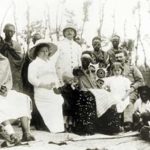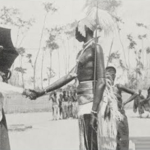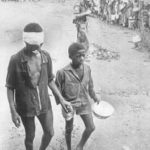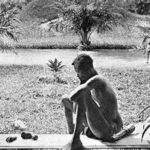Central Court Conflicts
Inbroader Rwandan politics, the sequel to Rwabugiri’s death was the emergence of an intense and bitter power struggle at the central court. This conflict, which culminated in late 1896 with a bloody coup d’état, affected not only the personnel of power, but also the whole nature of the political process in Rwanda. For a time, at least, the balance of power shifted strongly into the hands of the Abeega clan, particularly the Abakagara lineage of this clan. The factions involved later continued their struggle throughout the period of European rule.
Only a few months alter the Abapari arrival in Kinyaga, two brothers of the central court, Kabare and Ruhinankiko, and their nephew Rwidegembya
plotted to overthrow the legitimate king, Mibambwe Rutarindwa. They planned to replace Rutarindwa with a young boy, Musinga. Like Rutarindwa, Musinga was a son of Rwabugiri. But while Rutarindwa’s mother belonged to the Abakono clan, Musinga’s mother, Kanjogera, was a member of the Abakagara lineage of the Abeega clan, and she was the sister of Kabaare and Ruhinankiiko. Here, as in many other cases, the political ties of the mother’s family proved critical in the succession dispute which ensued, even superseding the former king’s explicit instructions. Rwabugiri had gone so far as to enthrone Rutarindwa as co-ruler before his death.
Three of the five previous queen mothers had come from the Abakagara lineage, and in the years before 1895, aided by the purges Rwabugiri staged against his own (paternal) Abahindiro royal lineage (Abanyiginya clan), leaders of the Abakagara lineage had moved into many of the most influential political posts of the kingdom, including first political counsellor to the king and principal military commander of royal armies, as well as queen mother. Only the kingship itself remained to be seized.
Abakagara control over the position of queen mother resulted directly from policies pursued by Rwabugiri. Several years before his death Rwabugiri had executed Rutarindwa’s mother after she had been implicated in a court intrigue: He then appointed his favorite wife, Kanjogera, as the adoptive mother for Rutarindwa, who was at that time heir-apparent. The Esoteric Code of Rwanda specifically proscribed appointing an adoptive queen mother who had given birth to her own royal son; in appointing Kanjogera, Rwabugiri went directly against the Code, as he seemed to have done on so many other occasions during his reign. As queen mother (umugabekazi) Kanjogera assumed not only ritual obligations but important political prerogatives. She actively encouraged her brothers’ plan to win the throne for her son Musinga, and remained as the power behind the throne for many years thereafter.
With his paternal lineage split over the succession and his maternal kinsmen weak, cut off from institutional access to him by the appointment of Kanjogera as queen mother, Rutarindwa found himself in a precarious position. Army corps loyal to his side was seriously weakened in the battle against the Abapari at Shangi; the Abeega may well have planned to put those soldiers at risk. Rutarindwa’s most prominent supporters were the ritual specialists (Abiiru) of the kingdom, especially the three principal Abiiru (Bisangwa, Sehene, and Mugugu), executors of Rwabugiri’s last testament. But shortly after Rutarindwa’s accession to power, Bisangwa son of Rugombituuri perished at Shangi in the battle against the Abapari. Bisangwa’s brother, Sehene, and Mugugu son of Shumbusho were assassinated through the machinations of Kabaare. Several of the powerful army companies which these three had commanded were placed under chiefs loyal to Kabaare and Kanjogera; the other companies were left weakened by the loss of their leaders. In early December 1896 the Abakagara forces made their move, attacking the royal court at Rucunshu, near Kabgayi in central Rwanda. Though Rutarindwa’s men put up a valiant defense, the Abakagara emerged victorious. Rutarindwa and his closest advisors committed suicide and the triumphant Abeega proclaimed Musinga king.
In the aftermath of the Rucunshu coup, Kanjogera undertook a purge of Rutarindwa’s brothers, uncles, and more distant cousins, thinning the ranks of the royal Abahindiro lineage. Some were assassinated on orders from the court, others fled into exile. The purge not only eliminated potential pockets of resistance; it also vacated positions which could then be filled by members of the Abakagara lineage and their supporters. The struggle between the Abakagara and Abahindiro lineages (often described as Abeega vs Abanyiginya, using the clan categories), was to form an ongoing theme of political competition over the next five decades.
This shift in power at the center generated significant changes in local patron-client ties, since those with links to a central patron who was on the losing side at Rucimshu found it necessary to switch allegiance. Consequently the role and importance of Abeega (in Kinyaga and elsewhere in Rwanda) increased substantially, as did the status of those who were linked to Abeega patrons (particularly members of the Abakagara lineage). And the Abeega seized on European occupation as an opportunity to augment their power.
https://uk.amateka.net/central-court-conflicts/https://uk.amateka.net/wp-content/uploads/2020/05/musinga.pnghttps://uk.amateka.net/wp-content/uploads/2020/05/musinga-150x150.pngChanges and ColonialismInbroader Rwandan politics, the sequel to Rwabugiri's death was the emergence of an intense and bitter power struggle at the central court. This conflict, which culminated in late 1896 with a bloody coup d'état, affected not only the personnel of power, but also the whole nature of the political...BarataBarata rpierre@ikaze.netAdministratorAMATEKA | HISTORY OF RWANDA




